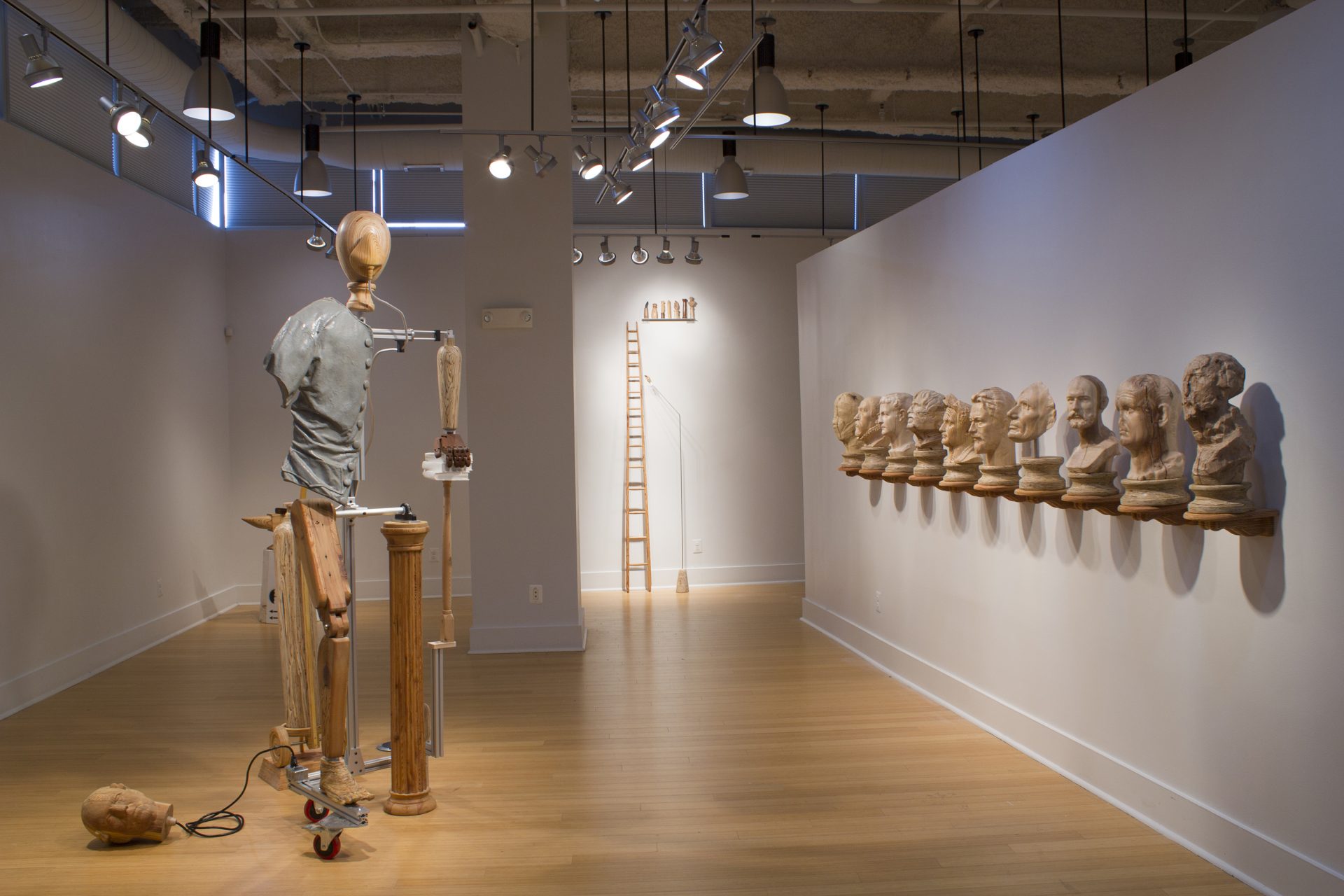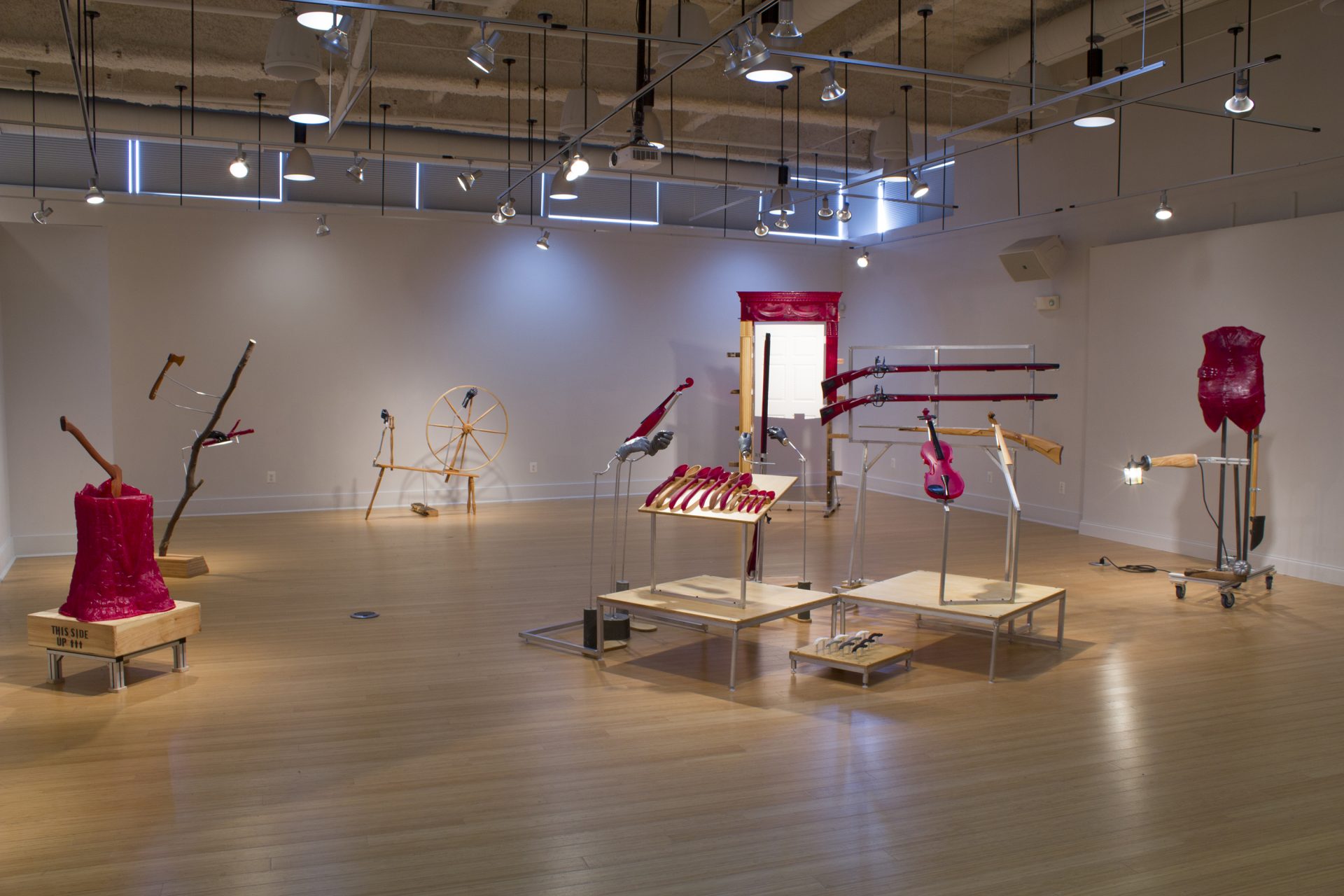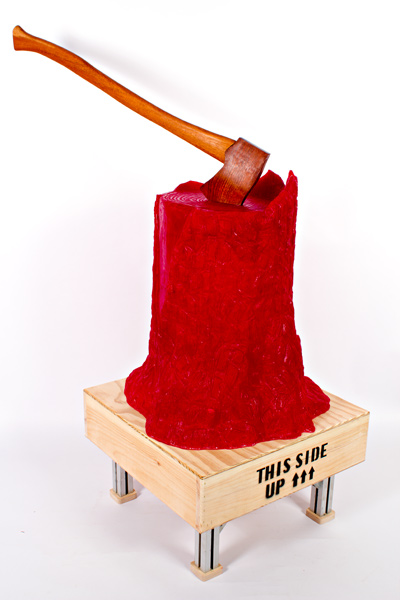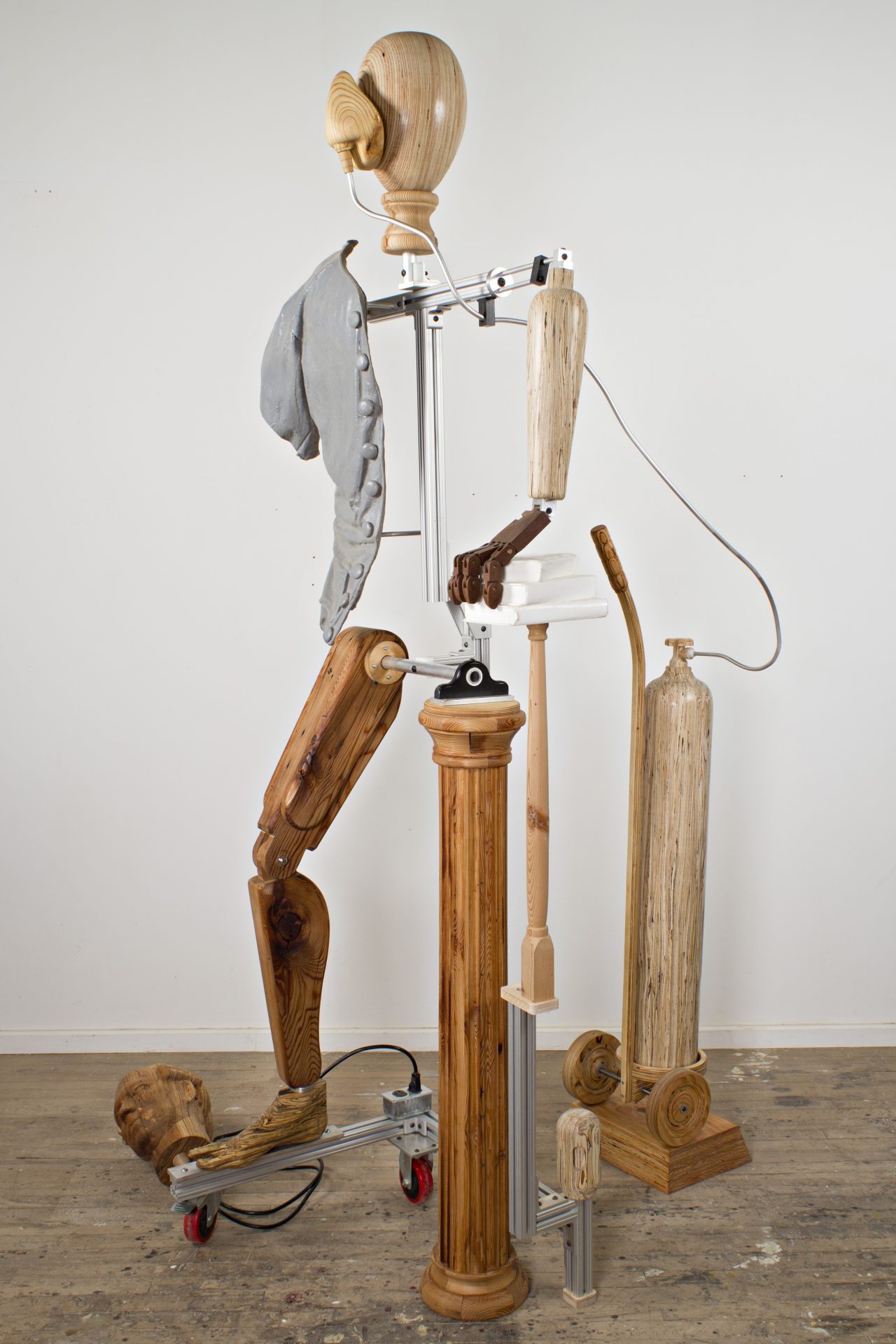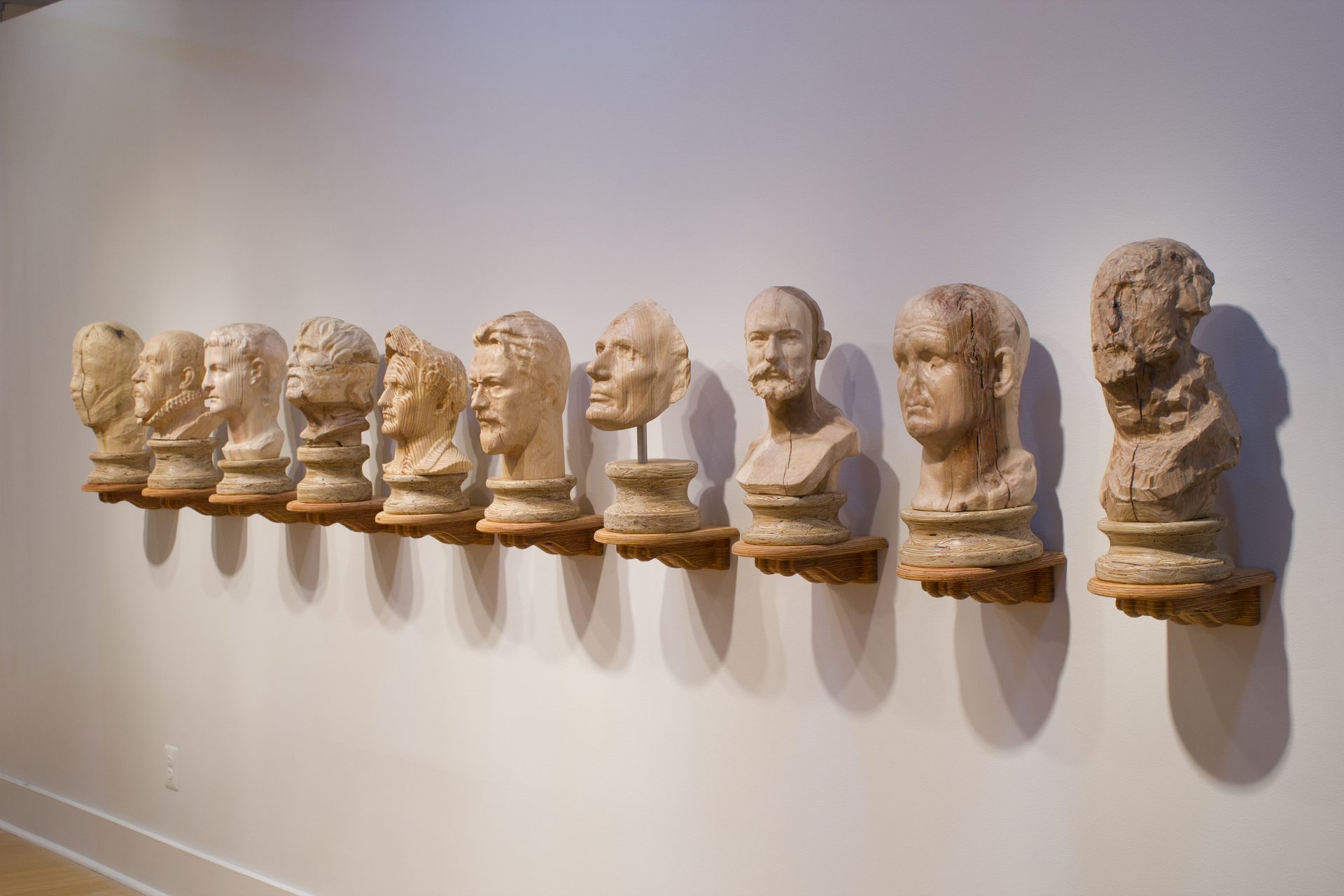By Noa West, June 21, 2017
VisArts had the pleasure of presenting sculptor and multimedia artist Lewis Colburn’s solo exhibition, two hundred and forty-two years, in the Kaplan Gallery, June 16 – July 16, 2017. Using 20th and 21st century processes such as digital fabrication, 3D scanning, welding, woodwork and mold making to create historically-based objects, Colburn fuses together eras of our time, questioning what is considered authentic, what is considered a replica, and “how the past creates the future.” His work stimulates questions regarding the significance, narratives, and nostalgia associated with historical artifacts. His sculptures and vignettes galvanize the imagination of viewers, urging them to create new narratives and perspectives around the 242 years of America as a nation. Noa West, our summer gallery intern, spoke with Lewis about his ideas, processes, and the two series of works he included in the exhibition: “Early America” and “A State of Permanent Discontent.”
Where did you grow up? Did you have fascinations as a child that show up in your work now?
I grew up in Cedar Falls, Iowa, a small college town in north-eastern Iowa, and also spent a lot of time in Minnesota as a kid. As far as fascinations— I’ve always been drawn to making things, and my parents encouraged me to do so from an early age. I grew up building things out of cardboard, sewing stuffed animals, noodling around with bandsaws and tools, and making costumes for myself. There’s a kind of pejorative term in writing about science fiction called ‘world-building’, i.e. those places in sci-fi writing where the author spends a lot of time explaining the intricacies of their imagined world, as opposed to moving the plot forward. I don’t think of that as a bad thing, though— I love the idea of world-building. I’ve always been drawn to these constructed worlds- the theater, film, fiction, even the kind of Dungeons and Dragons kind of gaming worlds. I think a lot about re-enactors now (though I most definitely am not a re-enactor and don’t participate in those events) but that’s another place where people are kind of collectively creating their own world. I’m drawn to those events now because they at least in name have some connection to the past, and hence to our world, as opposed to the more imaginary worlds of sci-fi or fantasy.
I thought I was going to be an architect for a long time— a kind of combination of problem-solving and making, but then I took my first sculpture class in undergrad and found myself spending hours and hours in the studio. I didn’t really think it was feasible to be an artist, but I just kept at it though grad school and onward, and here I am today.
What kind of conversation are you hoping to start when looking at “Early America” and “A State of Permanent Discontent?”
With a lot of these artworks, I’m interested in making something that exists between our known categories of objects between museum replica, movie prop, sculpture, theater set, etc. Blurring these lines points to how we shift and change our narratives about the past over time. Usually what we think is important in the past, the lessons we try to extract from it, tell us more about who we are today than anything objective that happened in the past. That’s a long-winded conceptual answer, but those are the high-level ideas I am thinking about. I also want the works to be physically seductive, to draw the viewer in and give them the opportunity to ask questions. If those questions focus on the era I’m dealing with in the work, so much the better.
Why name the series “A State of Permanent Discontent?”
The full title is, “A State of Permanent Discontent,” though I am still evolving my language. I am think about ‘state’ as a double entendre; a sense that it is a condition also these days, a political unit. Within a state of ‘permanent discontent’ there are always things that need to be pushed forward, approved, made better, and we should never be satisfied with where we’ve come.
Your sculptures are powerful in the way that they are simplistic and specific. How do you choose/ narrow down the elements— What guides your decision?
Most of the works start from a single object— the cast-plastic waistcoat in the context of The Colonist, the ornate molding in the case of Untitled (Federal Period), etc. I tend to arrive at these things by looking at images and objects from the past; in museums, in books, and also just via Google Image Search. For “Early America,” I also kept a mail-order catalog which caters to reenactors and living history interpreters in the studio, as it’s essentially a huge catalog of readymade replicas.
I also let the making process narrow down the decisions. The objects I make are usually at the intersection of visual/conceptual interest and a making process I either know, or am excited to learn more about. From there, once I have one object, I build off of it— creating a kind of infrastructure to hold it in space where I want it to be, and add in objects and elements as necessary to fill out the work.
Lewis Colburn, two hundred and forty-two years, installation view of “Early America” in the Kaplan Gallery at VisArts.
How does your use of materials, that didn’t exist at the time that these pieces were originally created, formulate your practice and the stories that you push through to people?
The plastic/ red resin used in the sculptures of “Early America” is a very clearly artificial late 20th, early 21st century medium. The red resin does belong in that time period, so it emphasizes that it is a replica or a fake, it’s something made now. The red plastic is sort of a new material, kind of candy-like, and it emphasizes the artificiality of these things. The other thing that I think about is the idea that, say that a museum conservator is preserving an object, let’s say a broken pot, the standard is that if they have to add material in to hold the thing together, that material should contrast with the original material, so it is clear what is an original and what is a repair. I think that that idea of something being cobbled together, coming from different eras is another important trait in the work.
“I think that that idea of something being cobbled together, coming from
different eras is another important trait in the work.” – Lewis Coburn
What is the significance of a replica?
I’m interested in replicas because of what they tell us about our present concerns with the past. Replicas always deviate in some way from the originals— whether because we aren’t familiar with the processes used to make the originals, or because we cannot get the original materials, or because authenticity doesn’t matter in the context where the replica will be displayed, for example. These little slippages between original and replica connect the artworks to bigger ideas about how we write and re-tell history—so making my own replicas is a way I can tie into these bigger narratives. I’m a 21st century person making replicas in the 21st century, so they’ll always differ somewhat from the original objects.
Lewis Colburn, Untitled (A Nation Built from Wood), 2014, cast urethane, ipe, mahogany, pine, plywood and aluminum extrusion, 53 x 36 x 23 inches
Objects such as a stump and an axe, a wheel, and a door frame are jumping-off points for my projects. In particular, I am interested in the approximations and shortcuts that we make in the interest of re-creating a given historical experience. For example, a period interpreter on Philadelphia’s Independence Mall, clad in an 18th-century frock coat sewn from flimsy polyester. Making my own meticulous replicas of historical objects generates its own little slippages and elusions; whether or not my objects can ‘pass’ as authentic. These slippages connect us to larger ideas about how we write and re-tell history, questioning the narratives we choose to emphasize and those we neglect.
Do you think about the modern use of collage and assemblage when creating your works? How does assemblage reinforce your ideas?
Several people have brought up the idea of collage in the context of these works. I think it’s an interesting question, because I haven’t really considered collage as a reference. Certainly, there are ideas of ‘sampling’ and re-combining objects in the work, but I think it’s also important that I make nearly all the objects myself. Collage and assemblage are typically pursued by re-combining existing images and objects— so this is an important distinction. Because the objects are all my own replicas, they bring another level of meaning to the work. At the same time, I think that there is a bit of truth to the postmodern idea that all we’re doing is re-combining existing ideas and forms, as opposed to the Modernist idea of making some new, sui-generis form that communicates meaning independently.

Lewis Colburn, A Story Told Too Many Times, 2017, pine, engineered wood products, ipé, cast urethane, aluminum,
polyethylene, hardware and electrical components, 94 x 54 x 60 inches
Are you constantly teaching yourself new skills as new projects come up?
That’s interesting to think about. I am sort of almost adding in skills, I guess. To give you a quick trajectory of what those are… One of the most valuable experiences that I have had in addition to my formal education at grad school was that I worked for two years in the scene shop of the Syracuse Stage as an assistantship. I would spend 20 hours a week building theatre sets, and so I had some basic woodworking and some welding and mold making after undergrad but at that point people just handed me a drawing and said, ‘Make this thing,’ you know? That experience really sharpened my building skills, challenging me to create big things cheaply and fast. As an artist, you sort of have to take whatever experience that you’re having and pull from it what is valuable. I love the problem solving; my wife and I joke about this, “The greatest gift you can give yourself as an artist is forgetting how horrible the last time was when you had to do it” I love the process, and I love being busy making these things, but when you come up for air, you seem to be like, ‘oh wow, that was totally nuts’ and you have to let yourself forget how demanding it was, and be seduced by the new thing and then you can do it again.
Are there other contemporary artists that are working with ideas of history that inspire you?
Right now, I think this is a big thread in contemporary art— there are a lot of people whose work I really love, but I also want to keep them at arm’s length in order to focus on my own work. I fall into and out of love with artists over time… the list could go on forever. I love artists who take the work further than the object— artists like Simon Starling, who has a hugely complex conceptual approach to his projects. I also admire artist Fred Wilson, for his engagement with the way museums collect and preserve objects, and the prejudices, categories, and biases this act of collecting reveals. Lately I’ve also been drawn to more purely sculptural works- someone like Marguerite Humeau, for example, with these kind of alien natural-history sculptures. Anyway, it could go on forever. You’ve got to be both a producer and a consumer of artwork, and be aware of what’s going on, but not let it blow you around too much, and keep at what you’re doing.
What statements have you claimed through your work that have challenged today’s audience to question and criticize our reality? How do you connect these works to the present?
That’s a huge and challenging question, and it is something that I’ll be frank with you, I probably have a much less thought out answer then I should. I guess one way to answer it would be to look at these two bodies of work that I am showing at VisArts— the “Early America” stuff and “The State of Permanent Discontent.” In the bigger sense, the answer is ‘yes.’ I want to challenge frameworks of thought and I want to challenge how the past creates the future.
“I want to challenge frameworks of thought and
I want to challenge how the past creates the future.” – Lewis Coburn
I loved the “Early America” time period, and because it gets foregrounded here in Philadelphia, I wanted to play with that sort of a cheesy manner. And then of course November 2016 came along and smacked me in the face as it did many of us. And so I looked at “Early America” and thought, ‘Boy, you could really read this in kind of an opposite way, sort of glorifying all this stuff.’ The thought of glorifying all these narratives got a lot uglier after 2016. And so, I think that was kind of a pivot where I thought that series came to its conclusion, and “Permanent Discontent,” and it probably doesn’t read as angry to the outside viewer, but its working is a little bit harder to subvert and pull a part these narratives. A big figure piece called “A Story Told Too Many Times”, is a western monument, but it’s on life support struggling forward. “Eight Dead White Men I Found on the Internet and Two Averages” — it’s about the same story that is told over and over again. In a bigger sense, you do wonder about the ethics of artwork, which actually reflect a changing world.
Lewis Colburn, Eight Dead White Men I Found on the Internet, and Two Averages, 2017,
engineered wood products, pine, oak, and poplar, dimensions variable, this configuration 20 x 144 x 10 inches
Lewis Colburn currently is a professor at Drexel University teaching sculpture. He received his undergraduate education at St. Olaf College in Studio Art and Russian and an MFA in sculpture at Syracuse University.

